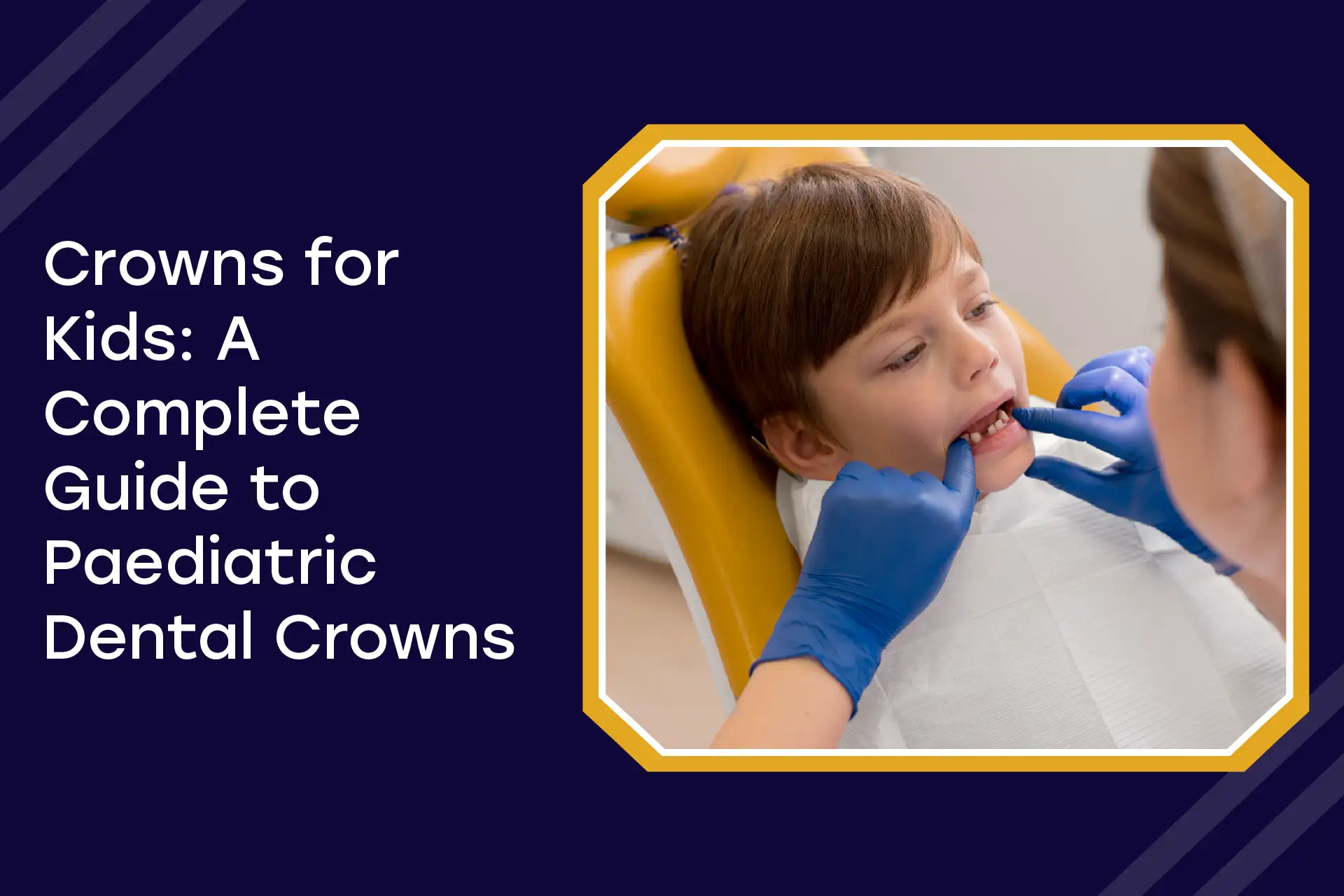Dental health is essential for everyone, especially children whose teeth and jaws are still developing. Paediatric dental crowns can be a helpful solution when a child’s temporary teeth face issues like decay, fractures, or other damage. In this guide, we’ll explore what dental crowns in paediatric dentistry are, why they’re used, and what parents can expect throughout the process.
A] What Are Paediatric Dental Crowns?
A paediatric dental crown is a protective cap that covers a damaged or weakened tooth in a child. It is designed to restore the tooth’s shape, size, and function until the permanent teeth emerge. Crowns are commonly used in paediatric dentistry to ensure that the temporary teeth—which play a critical role in chewing, speech, and alignment of permanent teeth—remain functional and healthy until they naturally fall out. You must visit a renowned dentist to put your baby’s teeth in the right hands. So, if you are looking for a paediatric dentist in Wadala, contact us. We will help your little ones have the healthiest and happiest smiles.
B] Reasons for Crowns in Paediatric Dentistry
Below are the reasons for getting paediatric crowns in kids:
1. Dental Decay
Dental decay is one of the most common reasons paediatric crowns are used. When cavities are extensive and cannot be restored with fillings alone, a crown may be needed to protect the tooth. The crown helps prevent further decay, ensuring the tooth remains intact and functional.
2. Fractured or Broken Teeth
Children can experience trauma or accidents that damage their teeth. Crowns help maintain the structure and function of fractured or broken baby teeth, allowing children to continue using their teeth for chewing and speaking without discomfort or risk of further damage.
3. Developmental Defects
Some children have developmental dental conditions, like enamel hypoplasia, where the enamel doesn’t form correctly. This condition leaves teeth vulnerable to wear and decay. Our dentists in Sion provide paediatric crowns for the extra protection these teeth need, helping to safeguard oral health.
C] Types of Crowns and Their Benefits
Below are the three types of crowns and their benefits:
1. Stainless Steel Crowns (SSC)
Stainless steel crowns are widely used in paediatric dentistry, especially for molars. They are known for their durability and cost-effectiveness, making them an excellent choice for back teeth, where aesthetics are less important. Stainless steel crowns last until the baby teeth fall out naturally, protecting them without frequent replacements.
2. Composite Strip Crowns
Composite strip crowns are ideal for restoring front teeth since they look more natural than stainless steel crowns. These crowns blend well with the natural colour of teeth, making them a preferred option for visible areas and offering both functionality and aesthetics.
3. Zirconia Crowns
Zirconia crowns are a relatively new option in paediatric dentistry but are gaining popularity. Known for their durability and aesthetic appeal, zirconia crowns are tooth-coloured and particularly strong, making them an excellent choice for visible teeth. They maintain the natural look of a smile while providing added strength.
D] The Paediatric Crowns Procedure
Below are the steps involved in the paediatric crown procedure:
1. Initial Evaluation and Preparation
The paediatric crown process begins with an assessment by our paediatric dentist in Wadala. The dentist examines the affected tooth and discusses the treatment plan with the parents. Preparation involves removing any decay and reshaping the tooth to accommodate the crown.
2. Crown Fitting Process
After the tooth is prepared, the crown is placed over it and secured with dental cement to ensure stability. The procedure involves numbing the area so the child remains comfortable throughout. For more extensive cases, some children may need sedation or general anaesthesia.
3. Recovery and Aftercare
Children might experience mild soreness, which typically subsides within a few days post-procedure. Parents should encourage soft foods for the first day or two and monitor the child’s oral hygiene to keep the crown tooth clean and healthy.
E] Benefits of Using Crowns in Paediatric Dentistry
Using crowns in paediatric dentistry has various benefits, including:
1. Protecting Dental Health
Crowns offer robust protection against further decay or structural weakening, particularly important in baby teeth prone to cavities. By covering and shielding these teeth, crowns prevent the spread of decay to adjacent teeth and keep the oral environment healthy.
2. Maintaining Tooth Function
Baby teeth play essential roles in chewing, speaking, and guiding permanent teeth into the correct positions. Crowns help preserve these functions, supporting a child’s overall development and oral health.
3. Aesthetic Improvements
Crowns and bridge treatments, especially composite and zirconia types, can improve the appearance of damaged teeth, giving children a natural, healthy smile even when tooth decay or trauma has caused damage.
F] Potential Risks and Considerations
Crowns are necessary for baby teeth, but they might have some potential risks:
1. Possible Discomfort or Sensitivity
Some children may experience mild discomfort or sensitivity in the area after a crown procedure. Are crowns painful for kids? Yes, a little, but this typically improves within a few days and can be managed with over-the-counter pain relievers.
2. Cost Factors
The cost of paediatric dental crowns varies depending on the type of crown and insurance coverage. Stainless steel crowns are generally more affordable, while zirconia and composite crowns are more costly due to their aesthetic benefits.
3. Replacement Considerations
In some cases, crowns may come loose or need replacement if they fall out before the permanent tooth emerges. Regular dental check-ups can help ensure the crown remains intact and functional.
Conclusion
Paediatric dental crowns play a valuable role in maintaining children’s oral health with damaged or decayed baby teeth. Protecting and restoring these teeth, crowns help ensure children can chew, speak, and smile confidently as they grow. Understanding the types of crowns, benefits, and potential risks can help parents make informed decisions about their child’s dental care. To ensure your child’s oral health is in expert hands, visit The Smile Canvas. We provide personalised care for growing smiles. If you’re also exploring options for crown and bridge treatment in Wadala, we’re here to help. Contact us today and give your little one the confidence of a healthy, happy smile!
FAQ’s
Yes, crowns can be necessary when a baby tooth is severely decayed, fractured, or weak, as they help preserve function and prevent further decay.
The best crown depends on the tooth’s location and aesthetic needs. Stainless steel crowns are durable for back teeth, while zirconia or composite crowns are ideal for visible front teeth.
Yes, children can eat normally after the initial recovery period, though avoiding hard or sticky foods is best.
Ensure your child maintains regular brushing and flossing and avoids biting on hard objects.
Yes, stainless steel crowns are safe, durable, and commonly used in paediatric dentistry.
Children’s crowns typically last until the baby tooth falls out naturally, although periodic check-ups are advised to ensure they remain in place.

Dr. Rishabh Pendurkar
Dr. Rishabh Pendurkar offers 16 years of clinical expertise, including his role as Consultant at the renowned Asian Heart Institute in Mumbai. Known for his precision and care, Dr. Pendurkar has successfully handled a wide spectrum of dental cases, from routine to complex treatments.


